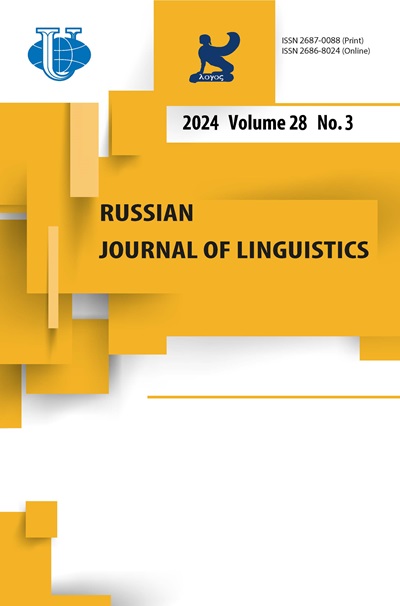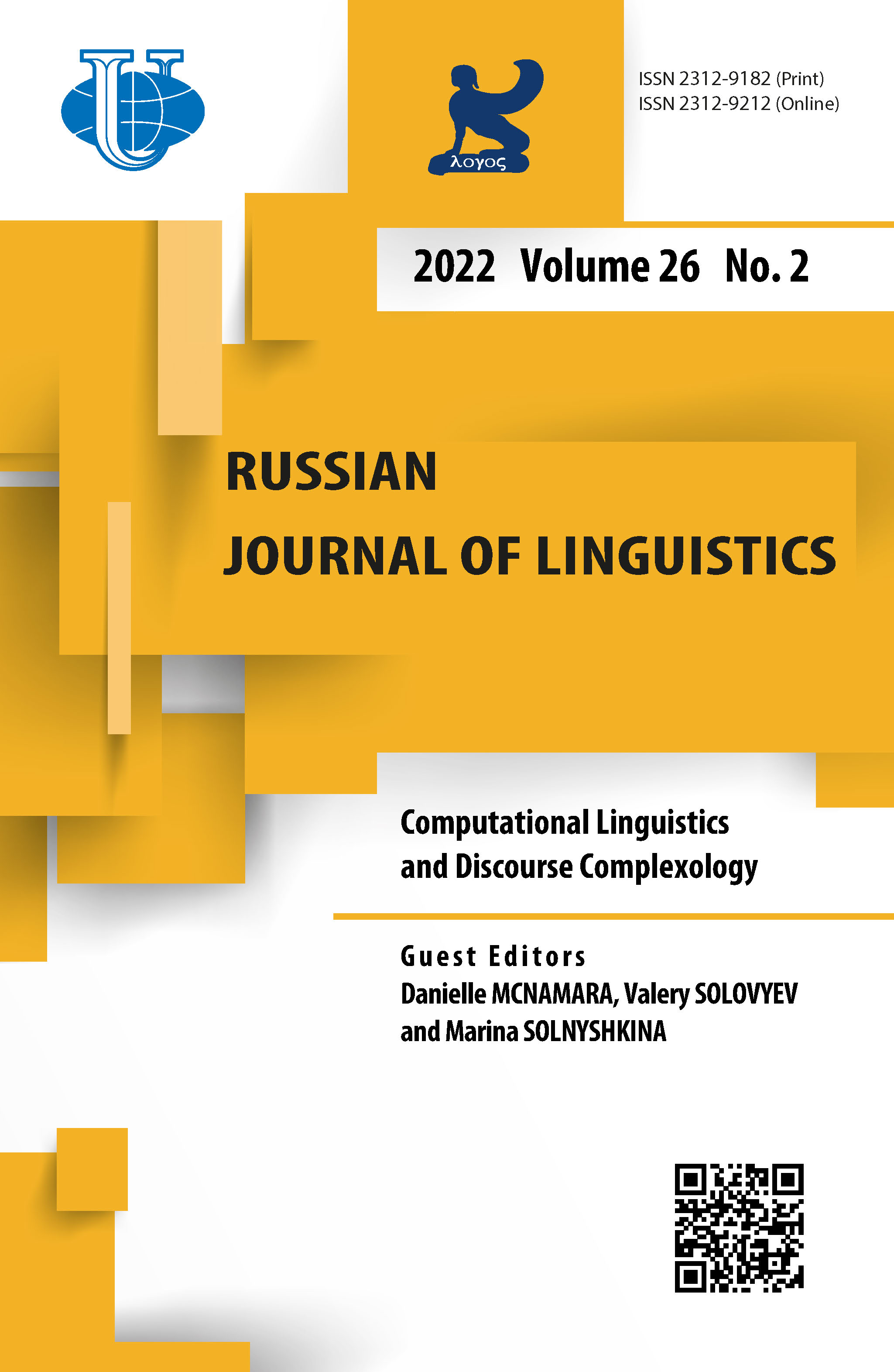Сложность текста и лингвистические признаки: как они соотносятся в русском и английском языках
- Авторы: Морозов Д.А.1, Глазкова А.В.2, Иомдин Б.Л.3
-
Учреждения:
- Новосибирский государственный университет
- Тюменский государственный университет
- Институт русского языка им. В. В. Виноградова РАН
- Выпуск: Том 26, № 2 (2022): Компьютерная лингвистика и дискурсивная комплексология
- Страницы: 426-448
- Раздел: Статьи
- URL: https://journals.rudn.ru/linguistics/article/view/31332
- DOI: https://doi.org/10.22363/2687-0088-30132
Цитировать
Полный текст
Аннотация
Автоматическая оценка читабельности текста - актуальная и непростая задача, которая требует учёта разнообразных лингвистических факторов. Сложность текста должна соответствовать уровню читателя: слишком сложный текст останется непонятым, слишком простой будет скучным. Исторически для оценки читабельности использовались простые характеристики: средняя длина слов и предложений, разнообразие лексики. Благодаря развитию методов обработки естественного языка набор используемых для оценки параметров текста существенно расширился. За последние годы было опубликовано множество работ, в которых исследовался вклад в сложность текста различных лексических, морфологических, синтаксических признаков. Тем не менее, поскольку использованные методы и корпусы довольно разнообразны, затруднительно делать общие выводы об эффективности различных лингвистических характеристик текста. Более того, не было проведено сравнение влияния признаков для различных языков. Целью настоящего исследования является проведение масштабного сравнения признаков различного характера. Мы экспериментально сравнили семь часто используемых типов признаков (индексы читабельности, традиционные, морфологические, синтаксические, пунктуационные, частотные признаки и тематическое моделирование) на материале трёх русскоязычных и трёх англоязычных корпусов, с использованием четырех распространённых алгоритмов машинного обучения: логистической регрессии, случайного леса, свёрточной нейронной сети и нейронной сети с прямой связью. Один из корпусов - корпус художественной литературы, читаемой российскими школьниками, - был создан для этого эксперимента с помощью масштабного опроса для обеспечения объективности разметки. Мы показали, какие типы признаков могут значительно повысить качество прогнозирования, и проанализировали их влияние в зависимости от характеристик корпуса, его языка и источника текстов.
Ключевые слова
Об авторах
Дмитрий Алексеевич Морозов
Новосибирский государственный университет
Email: morozowdm@gmail.com
ORCID iD: 0000-0003-4464-1355
младший научный сотрудник Лаборатории прикладных цифровых технологий Международного математического центра
Россия, 630090, Новосибирск, ул. Пирогова, д. 1Анна Валерьевна Глазкова
Тюменский государственный университет
Email: a.v.glazkova@utmn.ru
ORCID iD: 0000-0001-8409-6457
кандидат технических наук, доцент кафедры программного обеспечения Института математики и компьютерных наук
Россия, 625003, Тюмень, ул. Володарского, д. 6Борис Леонидович Иомдин
Институт русского языка им. В. В. Виноградова РАН
Автор, ответственный за переписку.
Email: iomdin@ruslang.ru
ORCID iD: 0000-0002-1767-5480
кандидат филологических наук, ведущий научный сотрудник
Россия, 119019, Москва, ул. Волхонка, д. 18/2Список литературы
- Blei, David M., Andrew Y. Ng & Michael I. Jordan. 2003. Latent dirichlet allocation. The Journal of Machine Learning Research 3. 993-1022. https://doi.org/10.1016/B978-0-12-411519-4.00006-9
- Burtsev, Mikhail, Alexander Seliverstov, Rafael Airapetyan, Mikhail Arkhipov, Dilyara Baymurzina, Nickolay Bushkov, Olga Gureenkova, Taras Khakhulin, Yuri Kuratov, Denis Kuznetsov, Alexey Litinsky, Varvara Logacheva, Alexey Lymar, Valentin Malykh, Maxim Petrov, Vadim Polulyakh, Leonid Pugachev, Alexey Sorokin, Maria Vikhreva & Marat Zaynutdinov. 2018. DeepPavlov: Open-source library for dialogue systems. In Proceedings of ACL 2018, System Demonstrations. 122-127. https://doi.org/10.18653/v1/P18-4021
- Cantos, Pascual & Ángela Almela. 2019. Readability indices for the assessment of textbooks: A feasibility study in the context of EFL. Vigo International Journal of Applied Linguistics 16. 31-52. https://doi.org/10.35869/VIAL.V0I16.92
- Chollet, Francois. 2015. Keras. Github. https://github.com/fchollet/keras (accessed 31.01.2022).
- Coleman, Meri & Ta Lin Liau. 1975. A computer readability formula designed for machine scoring. Journal of Applied Psychology 60(2). 283.
- Dale, Edgar & Jeanne S. Chall. 1948. A formula for predicting readability: Instructions. Educational Research Bulletin 27. 11-20, 37-54.
- Devlin, Jacob, Ming-Wei Chang, Kenton Lee & Kristina Toutanova. 2019. BERT: Pre-training of deep bidirectional transformers for language understanding. In Proceedings of the 2019 Conference of the North American Chapter of the Association for Computational Linguistics: Human Language Technologies, Volume 1 (Long and Short Papers). 4171-4186. Minneapolis, Minnesota. Association for Computational Linguistics. https://doi.org/10.18653/v1/N19-1423
- Deutsch, Tovly, Masoud Jasbi & Stuart Shieber. 2020. Linguistic Features for Readability Assessment. In Proceedings of the Fifteenth Workshop on Innovative Use of NLP for Building Educational Applications. Association for Computational Linguistics. 1-17. https://doi.org/10.18653/v1/2020.bea-1.1
- Feng, Lijun, Martin Jansche, Matt Huenerfauth & Noémie Elhadad. 2010. A comparison of features for automatic readability assessment. In Coling 2010: Posters. 276-284.
- Glazkova, Anna, Yury Egorov & Maksim Glazkov. 2021. A comparative study of feature types for age-based text classification. Analysis of Images, Social Networks and Texts. 120-134. Cham. Springer International Publishing. https://doi.org/10.1007/978-3-030-72610-2_9
- Honnibal, Matthew & Ines Montani. 2017. spaCy 2:Natural language understanding with Bloom embeddings, convolutional neural networks and incremental parsing. To appear.
- Iomdin, Boris L. & Dmitry A. Morozov. 2021. Who Can Understand “Dunno”? Automatic Assessment of Text Complexity in Children’s Literature. Russian Speech 5. 55-68. https://doi.org/10.31857/S013161170017239-1
- Isaeva, Ulyana & Alexey Sorokin. 2020. Investigating the robustness of reading difficulty models for Russian educational texts. In AIST 2020: Recent Trends in Analysis of Images, Social Networks and Texts. 65-77. https://doi.org/10.1007/978-3-030-71214-3_6
- Ivanov, Vladimir, Marina Solnyshkina & Valery Solovyev. 2018. Efficiency of text readability features in Russian academic texts, In Komp'yuternaya Lingvistika I Intellektual'nye Tehnologii. 284-293.
- Kincaid, J. Peter, Robert P. Fishburne Jr., Richard L. Rogers & Brad S. Chissom. 1975. Derivation of New Readability Formulas (Automated Readability Index, Fog Count and Flesch Reading Ease Formula) for Navy Enlisted Personnel. Naval Technical Training Command Millington TN Research Branch. https://doi.org/10.21236/ada006655
- Kingma, Diederik P. & Jimmy Ba. 2015. Adam: A method for stochastic optimization. ICLR.
- Korobov, Mikhail. 2015. Morphological analyzer and generator for Russian and Ukrainian languages. In International Conference on Analysis of Images, Social Networks and Texts. 320-332. Springer. https://doi.org/10.1007/978-3-319-26123-2_31
- Kuratov, Yuri & Mikhail Arkhipov. 2019. Adaptation of deep bidirectional multilingual transformers for Russian language. Komp’uuternaya Lingvistika i Intellektual’nye Tehnologii. 333-339.
- Kutuzov, Andrey & Elizaveta Kuzmenko. 2016. Web-vectors: A toolkit for building web interfaces for vector semantic models. In International Conference on Analysis of Images, Social Networks and Texts. 155-161. Springer. https://doi.org/10.1007/978-3-319-52920-2 15
- Leech, Geoffrey, Paul Rayson & Andrew Wilson. 2001. Word Frequencies in Written and Spoken English: Based on the British National Corpus. Routledge.
- Loper, Edward & Steven Bird. 2002. NLTK: The natural language toolkit. In Proceedings of the ACL-02 Workshop on Effective Tools and Methodologies for Teaching Natural Language Processing and Computational Linguistics. 63-70.
- Loshchilov, Ilya & Frank Hutter. 2018. Decoupled weight decay regularization. In International Conference on Learning Representations.
- Lyashevskaya, Olga & Serge Sharoff. 2009. The Frequency Dictionary of the Modern Russian Language (Based on the Materials of the Russian National Corpus). Moscow: Azbukovnik.
- Martinc, Matej, Senja Pollak & Marko Robnik-Sikonja. 2021. Supervised and unsupervised neural approaches to text readability. Computational Linguistics 47. 1-39. https://doi.org/10.1162/coli_a_00398
- McLaughlin, G. Harry. 1969. Smog grading - a new readability formula. Journal of reading 12(8). 639-646.
- Mikolov, Tomas, Edouard Grave, Piotr Bojanowski, Christian Puhrsch & Armand Joulin. 2018. Advances in pre-training distributed word representations. In Proceedings of the International Conference on Language Resources and Evaluation (LREC 2018).
- Pedregosa, Fabian, Gael Varoquaux, Alexandre Gramfort, Vincent Michel, Bertrand Thirion, Olivier Grisel, Mathieu Blondel, Peter Prettenhofer, Ron Weiss, Vincent Dubourg, Jake Vanderplas, Alexandre Passos, David Cournapeau, Matthieu Brucher, Matthieu Perrot & Edouard Duchesnay. 2011. Scikit-learn: Machine learning in Python. The Journal of Machine Learning Research 12. 2825-2830.
- Rehurek, Radim & Petr Sojka. 2010. Software framework for topic modelling with large corpora. In Proceedings of the LREC 2010 Workshop on New Challenges for NLP Frameworks.
- Reimers, Nils & Iryna Gurevych. 2019. Sentence-bert: Sentence embeddings using siamese bert-networks. In Proceedings of the 2019 Conference on Empirical Methods in Natural Language Processing. 3982-3992. Association for Computational Linguistics. https://doi.org/10.18653/v1/D19-1410
- Reimers, Nils & Iryna Gurevych. 2020. Making monolingual sentence embeddings multilingual using knowledge distillation. In Proceedings of the 2020 Conference on Empirical Methods in Natural Language Processing. 4512-4525. Association for Computational Linguistics. https://doi.org/10.18653/v1/2020.emnlp-main.365
- Senter, R. J. & E. A. Smith. 1967. Automated readability index. AMRL-TR. Aerospace Medical Research Laboratories. 1-14.
- Solnyshkina, Marina, Vladimir Ivanov & Valery Solovyev. 2018. Readability formula for Russian texts: A modified version. In Mexican International Conference on Artificial Intelligence. 132-145. Springer. https://doi.org/10.1007/978-3-030-04497-8_11
- Templin, Mildred C. 1957. Certain Language Skills in Children; Their Development and Interrelationships. Minneapolis: University of Minnesota Press.
- Vajjala, Sowmya & Ivana Lucic. 2018. OneStopEnglish corpus: A new corpus for automatic readability assessment and text simplification. In Proceedings of the Thirteenth Workshop on Innovative Use of NLP for Building Educational Applications. 297-304. Association for Computational Linguistics. https://doi.org/10.18653/v1/W18-0535
- Wolf, Thomas, Lysandre Debut, Victor Sanh, Julien Chaumond, Clement Delangue, Anthony Moi, Pierric Cistac, Tim Rault, Remi Louf, Morgan Funtowicz, Joe Davison, Sam Shleifer, Patrick von Platen, Clara Ma, Yacine Jernite, Julien Plu, Canwen Xu, Teven Le Scao, Sylvain Gugger, Mariama Drame, Quentin Lhoest & Alexander Rush. 2020. Transformers: State-of-the-art natural language processing. In Proceedings of the 2020 Conference on Empirical Methods in Natural Language Processing: System Demonstrations. 38-45. https://doi.org/10.18653/v1/2020.emnlp-demos.6
- Xun, Guangxu, Vishrawas Gopalakrishnan, Fenglong Ma, Yaliang Li, Jing Gao & Aidong Zhang. 2016. Topic discovery for short texts using word embeddings. In 2016 IEEE 16th International Conference on Data Mining (ICDM). 1299-1304. IEEE.
- Yan, Xiaohui, Jiafeng Guo, Yanyan Lan & Xueqi Cheng. 2013. A biterm topic model for short texts. In Proceedings of the 22nd International Conference on World Wide Web. 1445-1456. https://doi.org/10.1145/2488388.2488514
- Chapter 699a. Readable language in insurance policies. URL: https://www.cga.ct.gov/current/pub/chap_699a.htm#sec_38a-29 (accessed 29.05.2022).
- Readability. 2021. URL: https://github.com/morozowdmitry/readability (accessed 29.05.2022).
- Readability 0.3.1. 2019. URL: https://pypi.org/project/readability/ (accessed 29.05.2022).

















